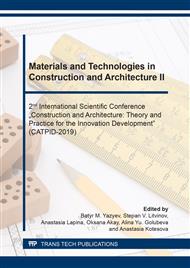[1]
V.K. Demidovich, Penosteklo, Science and Technology,, Minsk, (1975).
Google Scholar
[2]
L.I. Dvorkin, O.L. Dvorkin, Construction materials from waste industry, Phoenix, Rostov-on/D? (2007).
Google Scholar
[3]
O.V. Kazmina, V.I. Vereshchagin, A.N. Abiyaka, Foamglass-crystalline materials based on natural and man-made materials, Publishing House of Tomsk Polytechnic University, Tomsk, (2014).
Google Scholar
[4]
N.I. Minko, O.V. Puchka, M.N. Stepanova, S.S. Weisser, Thermal insulation glass materials, Foam glass: 2nd ed. Belgorod: BSTU named dafter V. G. Shukhov, (2016).
Google Scholar
[5]
N.I. Minko, O.V. Puchka, E.I. Evtushenko, V.M. Nartsev, S.V. Sergeev, Foam glass is a modern efficient inorganic heat-insulating material, Basic Research. 6-4 (2013) 849-854.
Google Scholar
[6]
E.V. Veselovskaya, A.G. Shishlo, Experience of using promising water treatment technologies in domestic thermal power plants, Bulletin of the Universities of the Northern Caucausus Region Tech. science. 2 (2016) 62 - 66.
Google Scholar
[7]
G.I. Ovcharenko, D.I. Gilmiyarov, Strength and phase composition of autoclaved material: an approximation, Magazine of Civil Engineering. 83(7)2018 63–72.
Google Scholar
[8]
M.A. Frolova, A.S. Tutyigin, A.M. Aizenshtadt, V.S. Lesovik et al, Assessment criterion of surface energy properties, Nanosystems: Physics, chemistry, mathematics. 2 (4) (2011) 120–125. (In Russian).
Google Scholar
[9]
V.S. Lesovik, N.I. Alfimova, A.V. Savin, A.V. Ginzburg, N.N. Shapovalov, Assessment of passivating properties of composite binder relative to reinforcing steel. World Applied Sciences Journal. 24 (12) (2013) 1691–1695.
Google Scholar
[10]
N.I. Alfimova, M.S. Sheychenko, S.V. Karatsupa, E.A. Yakovlev, A.S. Kolomatskiy, N.N. Shapovalov, Features of application of high-mg technogenic raw materials as a component of composite binders. Advances in Environmental Biology. 8 (13) (2014) 134–138.
Google Scholar
[11]
O.V. Kovalchenko, N.I. Alfimova, On the use of volcanic products in building materials science,Bulletin of BSTU named after V.G. Shukhov,6 (2017)24–28.(In Russian).
Google Scholar
[12]
N.I. Alfimova, N.N. Shapovalov, E.E. Shadsky, T.G. Yurakova, Improving the efficiency of using the products of volcanic activity , Bulletin of BSTU named after V.G. Shukhov. 5 (2015) 11–15.(In Russian).
Google Scholar
[13]
N.I. Alfimova, I.U. Vishnevskaya, P.V. Trunov, Influence of raw materials of volcanic origin and modes of hardening on the activity of composite binders, Bulletin of BSTU named after V.G. Shukhov. 1 (2011) 52–55. (In Russian).
Google Scholar
[14]
N.I. Alfimova, Improving the effectiveness of wall stones through the use of man-made materials, Bulletin of BSTU named after V.G. Shukhov.2(2011)56-59. (In Russian).
Google Scholar
[15]
X.Y. Cong, S. Lu, Y.Yao, Z. Wang, Fabrication and characterization of self-ignition coal gangue autoclaved aerated concrete, Materials and Design. 97 (2016) 155–162.
DOI: 10.1016/j.matdes.2016.02.068
Google Scholar
[16]
Ying-Liang ChenMing-Sheng KoJuu-En ChangChun-Ta Lin, Recycling of desulfurization slag for the production of autoclaved aerated concrete Article Jan, Construction and Building Materials.158 (2018) 132–140.
DOI: 10.1016/j.conbuildmat.2017.09.195
Google Scholar
[17]
Tingting Zhang, Yunliang Zhaо, Wei Wang, Shaoxian Song, A Novel Model of Aggregate Gradation for Autoclaved Bricks from Tailings, Minerals. 7(7) (2017) 112.
DOI: 10.3390/min7070112
Google Scholar
[18]
M.S. Ageeva, N.I. Alfimovа, Effective composite binders based on technogenic raw materials. Monograph. Saarbrucken. (2015) 84.
Google Scholar
[19]
R.V. Lesovik, N. Ryapukhin, M.S. Ageeva, Fine-grained concrete on industrial sands for bridge structures. Monograph. Saarbrucken. (2016) 168.
Google Scholar
[20]
T.V. Anikanova, A.S. Pogoromsky, The use of semi-aquatic calcium sulfate to intensify the processes of hardening of structural heat-insulating foamed concrete. Construction Materials and Products. 1(3) (2018) 25–32. (In Russian).
DOI: 10.34031/2618-7183-2018-1-3-25-32
Google Scholar
[21]
M.S. Ageeva, G.A. Lesovik, S.M. Shapovalov, O.N. Mikhailova et al., The effect of grinding time on the properties of a composite binder, Bulletin of BSTU named after V.G. Shukhov. 4 (2015) 28-32.
Google Scholar
[22]
Alexander Fomin, P. Khavanov, M.I. Kozhukhova, Autoclave Composites Containing Ferriferous Industrial By-Products, Materials Science Forum. 945 (2019) 1030-1035.
DOI: 10.4028/www.scientific.net/msf.945.1030
Google Scholar
[23]
E.V. Fomina, N.I. Kozhukhova, S.V. Sverguzova, A.E. Fomin, Application of mathematical model methods for optimization tasks in construction materials technology, Journal of Physics: Conference Series, 1015 (5) ( 2018) 052015,17DUMMY.
DOI: 10.1088/1742-6596/1015/5/052015
Google Scholar
[24]
N.I. Alfimova, S.Yu. Pirieva, D.V. Gudov, I.M. Shurakov, Е.Е. KorbutOptimization of receptural-technological parameters of manufacture of cellular concrete mixture, Construction Materials and Products, 1 (2) (2018) 30–36. (In Russian).
DOI: 10.34031/2618-7183-2018-1-2-30-36
Google Scholar
[25]
A.N. Sapelin, M.Yu. Elistratkin Light concrete new generation, Bulletin of BSTU named after V.G. Shukhov,2014. No. 4. P. 79-83. (In Russian).
Google Scholar
[26]
V.S. Lesovik, Improving the efficiency of production of building materials, taking into account the genesis of rocks. Moscow: Publishing Association of Construction Universities. (2006) 526. (In Russian).
Google Scholar
[27]
A.I. Bedov, V.V. Babkov, A.I. Gabitov, D.V. Kuznetsov et al., Possibilities of ensuring the operational reliability of the exterior walls of buildings based on autoclaved aerated concrete blocks, Vestnik MGSU. 1 and 2 (2011) 259-262. (In Russian).
Google Scholar
[28]
Yu.М. Boott and V.V. Timashev. Tutorial on chemical technology of binding materials Moscow: Vischa shkola. (1973) 504. (In Russian).
Google Scholar
[29]
V.V. Nelyubova, D.A. Chareev, V.V. Strokova et al., Laboratory autoclave for hydrothermal synthesis of building materials. Construction Materials. 3 (2012) 18–19. (In Russian).
Google Scholar
[30]
V.V. Babkov, A.I. Gabitov, N.S. Samofeev, Physico-chemical processes occurring in the structure of silicate brick in the cycle of operation of the exterior walls of buildings, Bashkir Chemical Journal. 18(2) (2011) 180-184. (In Russian).
Google Scholar
[31]
V.V. Vlasov, L.G. Barsukova, G.G. Krivneva, E.V. Bautina, Structural changes of cellular silicate concrete in walling after prolonged use, Building materials. 1 (2008) 18-19. (In Russian).
Google Scholar


